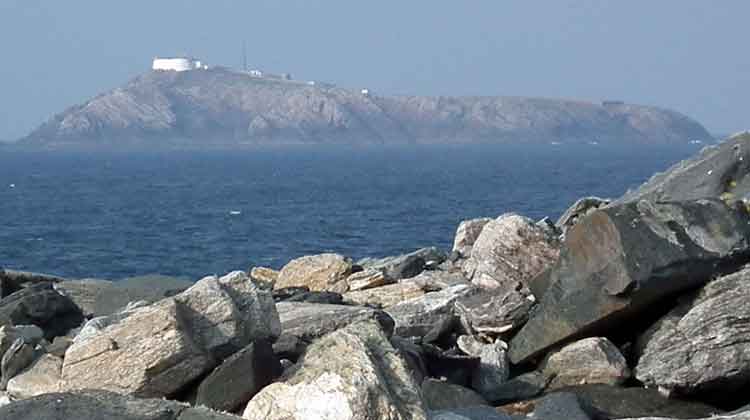Eagle Island, off the north end of the Mullet Peninsula in Erris, Co Mayo, was once home to the families of the island’s two lighthouse keepers.
The two lighthouses on Eagle Island were switched on in September 1835. One of the lighthouses stopped functioning after it was damaged beyond repair by a storm in 1894, but the powerful beacon of the second lighthouse continues to this day to warn and guide ships navigating the waters off the treacherous North Mayo coastline.
The lighthouses were built by the Ballast Board, also known as the Corporation for Preserving and Improving the Port of Dublin, which was established in 1786 and was responsible for the construction of lighthouses around the coast of Ireland.
The Eagle Island Lighthouses were designed by George Halpin Senior, (1776-1854), Inspector of Works and Lighthouses, and built at a cost of £30,000. The stone used to build the lighthouses was brought from Dún Laoghaire (Kingstown) and partly quarried on the island.
Halpin’s design is described as a tapering tower with a lantern encircled by serpentine railings on a corbelled walkway.
The lighthouses were located in the east and in the west of Eagle Island (Oileán san Tuaidh) with 132 yards between them. The lights were aligned at a height of 220 feet above sea level and could be seen to the east as far as Broadhaven Bay and to the south as far as Blacksod Bay.
However, the small island which takes the full brunt of the North Atlantic winter gales was never well suited to human habitation.
The lighthouse keepers’ families lived on the island for decades before they were rehoused near to Corclough on the mainland at the end of the 19th century. The keepers’ families lived in the pretty dwellings in Corclough until the houses were sold in 1956.
U-Boat Activity
The lighthouse keepers were ferried to Eagle Island from Scotchport where the boats that also brought supplies to the lighthouse were kept in a lovely old boathouse that is still in use to this day.
Over the course of the 20th century’s two world wars, many Allied ships were sunk by German U-Boats within sight of Eagle Island.
World War 1 came close to Eagle Island in 1915 when the SS Cherbourg, a collier, out of Glasgow was attacked and sunk by gunfire from German U-Boat 13 miles off the island. The crew of 25 were saved and taken to Belmullet, according to a report published on May 4th 1915 in the Tralee-based newspaper, The Liberator.
The lighthouse keepers remained on the Eagle Island until the 31st March 1988 when Eagle Island lighthouse was made automatic and there has been no lighthouse keeper resident on the island since as is the case with Blackrock Lighthouse, at the southern end of the Mullet.
Eagle Island station is now in the care of an attendant and the aids to navigation are also monitored via a telemetry link from the Commissioners of Irish Lights (CIL) Lighthouse Depot in Dun Laoghaire.


5 replies on “Eagle Island was once home to lighthouse keepers’ families”
I am looking for information about my Keegan ancestors who worked as Lighthouse Keepers on Eagle Island.
I am looking for my great-great grandfather, Richard Keegan. I understand that two brothers, John and James Keegan, were the lighthouse keepers.
I found Richard Keegan and it said he was in the Coastguard.
Richard was in Belmullet and John and James were allegedly in Doohoma.
Please email me at muzzaplant@msn.com if you can be of any help.
Thanks,
Donna Conner
LikeLike
My GG Grandfather, Alexander Power, was Light Keeper at Eagle Island from spring of 1863 to May 1865, when he was moved to Inishgort.
Martha, thanks for sharing your connection with Eagle Island. Anthony Hickey
LikeLike
My great grandmother was visiting her brother, Tom Ryan, who was a keeper on the night of the storm, 29th December 1894. She and her sister wrote very descriptive letters detailing the fear and terror they all felt when the sea started to tear the houses apart.
Thanks for sharing that, Bibi. I have read the account of the storm written by your great grandmother and her sister. I will try and find it and add it to this post.
Anthony
LikeLike
My grandfather, TL Duff, from Glasgow, was the owner of the SS Cherbourg which was sunk off Eagle Island in 1915. I’m planning to visit Eagle Island in May/June of this year 2018, and wonder if there is any local information about this event.
LikeLike
The Inniskea Islanders called Eagle Island “Illaunsatuai” which, of course, is “Oilean sa Tuaidh” meaning the Island in the North.
It took me aeons to figure out what Illaunsatuai meant. As a young lad growing up in Surgeview, it was many a time I heard the long mournful drone of the fog horn coming from Eagle which sadly went silent when modern technology made it redundant.
Thomas, thanks for that interesting and valuable piece of information about the true origins of the island’s name – and meaning behind it.
Anthony Hickey
LikeLike